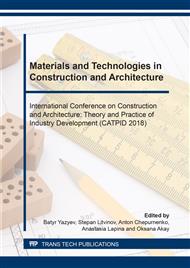p.643
p.649
p.653
p.661
p.667
p.674
p.681
p.687
p.692
Designing the Composition of Concrete with Mineral Additives and Assessment of the Possibility of Cracking in Cement-Concrete Pavement
Abstract:
Cement-concrete pavement not only has a long service life even at high loads but also has competitive production costs and fewer significant maintenance costs. The concrete road surfaces, thus, are rather economical. In this article, the Vietnamese Standard TCVN 9382 - 2012 was used to determine the heavyweight concrete composition for rural road construction. Assessment of the crack appearance in the concrete block body was made by the temperature field analysis, the thermal stress and cracking index. The conducted studies' result provided with the possibility of obtaining heavyweight concrete from Vietnam local raw materials regarding to the concrete mixture workability of 11-13 cm standard cone, 31-36 MPa compressive strength of heavyweight concrete at the age of 28 - day - normal hardening and 0.30 - 0.42 MPa average water resistance of samples. Using natural pozzolan to replace 20% of mass cement in the concrete mixture leads to a decrease in the concrete strength characteristics at different ages. The concrete compressive strength of composition No2 decreased mostly by 23% at the age of 3 days and least by 14% at the age of 28 days in comparison these values of composition No1. However, all of these concrete compressive strengths at the age 28 days are higher than 30 MPa. Replacing 20% of the mass Portland cement by natural pozzolan in a concrete mix will decrease price for 1 m3 concrete of 219.96 rubles. By applying the computer program MIDAS CIVIL, the maximum temperature in the concrete block center which was determined after 12 hours from the commencement of mixing of raw materials with water, equals to Tmax = 34.61 0С. At the same time, the structure temperature difference between the center (node793) and surface (nodes 120 and 898) of the concrete pavement can be neglected because of its insignificance. Besides, the cracking indexes at three hazardous locations of investigated structure are higher than 1, the cement-concrete pavement will be considered as non-appearance of cracks. However, the cracking index at center (node 793) is always less than this on the surface (nodes 120 and 898), equally to higher thermal crack occurrence at center. Therefore, it is necessary to monitor the development and expansion of thermal cracks to ensure the concrete mixture proper care during the hardening process.
Info:
Periodical:
Pages:
667-673
Citation:
Online since:
September 2018
Authors:
Price:
Сopyright:
© 2018 Trans Tech Publications Ltd. All Rights Reserved
Share:
Citation:


